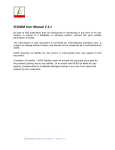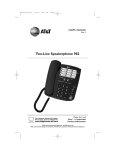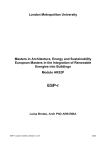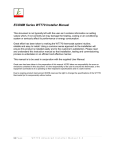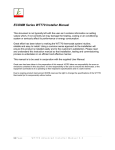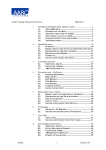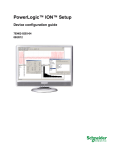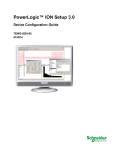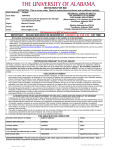Download ECOMM User Manual V 2.0 Europe - Adaptive Wireless Solutions, Ltd
Transcript
ECOMM User Manual V 2.0 Europe No part of this publication may be reproduced or distributed in any form or by any means, or stored in a database or retrieval system, without the prior written permission of KCRS and Adaptive Wireless Solutions Ltd. The information in this document is furnished for informational purposes only, is subject to change without notice, and should not be construed as a commitment by Adaptive Wireless Solutions Ltd. KCRS and Adaptive Wireless Solutions Ltd assume no liability for any errors or inaccuracies that may appear in this document. Limitation of Liability - KCRS and Adaptive Wireless Solutions Ltd liability shall not exceed the purchase price paid for the products giving rise to any liability. In no event shall KCRS be liable for any special, consequential or incidental damages arising in any way from using this product by the customers. 1 ECOMM Products User Manual Version 2.0 ‐ Europe Table of Contents Architecture Page 3 Definitions Page 4 Planning Page 5 Wireless Geography Page 18 Configuration Page 22 Configuring FFD’s Page 30 FFD Register Maps Page 33 Configuring RFD’s Page 36 RFD Register Maps Page 37 Input / Output Modules Channel Function Selection Page 38 EC1 Configuration Details Page 40 Characterized 3rd Part Device Settings Page 48 2 ECOMM Products User Manual Version 2.0 ‐ Europe Architecture • • • • • • • • • • Mesh Architecture is Star-Mesh-PAN Coordinator IEEE 802.15.4 ISM Band 2.4 GHz 75 Full Function Nodes ( Standard Architecture / Custom for OEM ) 150 Reduced Function Nodes ( Standard Architecture / Custom for OEM ) Multiple Networks can operate in the same geography FFD’s can Support Characterized 3rd Party Modbus RTU RS485 Slave Devices FFD’s and RFD’s can support custom Embedded Applications OEM Architectures 3rd Party Devices with Proprietary Protocols can also be “Characterized” All Radio Nodes on the Mesh can be Re-flashed/upgraded over the Mesh 3 ECOMM Products User Manual Version 2.0 ‐ Europe Definitions 802.15.4 This is the IEEE Standard which governs the ISM Band devices and operating characteristics, that include total Bandwidth, Transmission Intervals and Power levels of the various devices. 802.15.4 is similar to 802.11 (WiFi) in that the Frequency Spectrum is the same, 2.4 GHz with 16 Channels. One major difference is that the total 802.15.4 Network Bandwidth is limited to 250 kbps. PAN Private Area Network meaning a radio network other than a Local Area Network (LAN) or Wide Area Network (WAN) ISM Instrument / Scientific / Medical band is the term generally used for license-free radio bands used worldwide by commonly-used radio equipment in these sectors. The 2.4GHz ISM band is the band used by most devices manufactured conforming to the IEEE 802.15.4 radio Standard. PAN Coordinator This is the Private Area Network Coordinator which discovers and continuously manages the Network Devices. Referred to in this document also as the wireless gateway. FFD The FFD or Full Function Device can operate as both an I/O device and a network Router /Repeater and is a key device in the Mesh Network architecture. Usually linepowered as they have to stay on all the time. RFD The RFD or Reduced Function Device only handles I/O and does not route signals from other devices. It is therefore dependent upon the FFD’s to broadcast and receive communications over the Mesh Network. Most often battery-powered and uses sleep-mode to conserve power. Sleep-mode operation is a key feature designed into the 802.15.4 standard 4 ECOMM Products User Manual Version 2.0 ‐ Europe Transmit Sensitivity The power level at which an individual radio Node transmits. Receive Sensitivity The functional efficiency of the radio Node at receiving transmissions. Planning This section of the manual should be thoroughly read and understood as it is the most important factor in terms of assuring a successful deployment of the ECOMM products. There are many examples and metrics which can be applied in a common sense approach to engineering your wireless application in the real world. The fact is that the major consideration for employing Wireless Mesh technology in Automation and Control applications is to reduce cost. A secondary reason is to reduce deployment time, which also reduces cost. The ECOMM products detailed in this manual have been in continuous production since 2005. There are hundreds of thousands of devices operating in a multitude of different applications and environments. The single most common reason for difficulties encountered in deploying any radio products is exceeding the various devices’ effective range. The following pages show what those limitations are. The metrics are not absolute, primarily due to the tremendous numbers of physical variations that can be encountered in any site. Those barriers to radio communication are common elements of consideration that every potential site will have. Distance, walls, floors, organic material, and other radio systems, to name the most common. Distance Line of sight distance is a metric that all radio product manufacturers will cite as a performance metric. It is easy to qualify that metric when there are no obstacles between the two measured points and it is extremely consistent. How many times have you been talking on your mobile phone while driving in a car with 4 bars on the communication signal strength icon when simply moving another hundred metres down the road makes the signal strength go to zero bars. 5 ECOMM Products User Manual Version 2.0 ‐ Europe The distance metric in open air with line-of-sight conditions between the ECOMM FFD’s and/or PAN Coordinator is 427 metres (1,400 ft). Move the Nodes to 442 metres (1,450 ft) apart and the communication link is gone between those two Nodes. If any two Nodes have an obstacle between them the 427 metres operational distance will be reduced by a factor. The factor is variable depending upon the type of material the obstacle is constructed from and the thickness and density of that material. A common material encountered would be 10 cm (4”) interior construction plasterboard stud partition. In this case each wall between the FFD’s reduces the effective operational distance by 50% but still provides useful range in a building context. 6 ECOMM Products User Manual Version 2.0 ‐ Europe Another common material encountered would be cinder/thermalite block walls. The metrics on this material are shown below. The per obstacle signal strength loss here is far more significant, about 75% but still provides useful range in a building context. 7 ECOMM Products User Manual Version 2.0 ‐ Europe Another common material for walls and floors is concrete. Many central plant machine rooms and other areas in lower floors of high-rise structures have load bearing concrete walls of varying thicknesses and densities. Often the most advantageous location to place the wireless gateway would seem to be adjacent to the automation system panel, which often may be located in a central plant environment or equivalent. In reality a far better location from a radio mesh perspective might be a hallway ceiling 15 metres (50 ft) horizontally distant from the automation panel, thus eliminating 1 or 2 concrete walls as obstacles. Yes, it will cost the installer a bit more conduit and CAT 5 cable than was originally planned for, but it will eliminate possibly many hours of frustrating radio network troubleshooting where the possible eventual remedy will be to move the wireless gateway to that location anyway. Applications for mesh networks where the radio signal goes from indoor to outdoor locations are very common. Here are some simple Do’s and Don’ts. 8 ECOMM Products User Manual Version 2.0 ‐ Europe In this example by locating the FFD on the outside wall of the main building as opposed to leaving it inside, the 200mm cinder/thermalite block wall was eliminated as a radio transmission barrier giving the FFD a broadcast range of 427 metres vs. the 107 metres it would have if it were inside the building. Yes, the cost of an IP66 enclosure and drilling a hole through the wall for power wiring was perhaps not contemplated, but it would most likely be less expensive than trenching 213 metres for underground communication cable. 9 ECOMM Products User Manual Version 2.0 ‐ Europe When vertical and horizontal barriers are both brought into the equation another set of considerations is necessary. Concrete is the predominant material encountered for floor construction in many structures. Using the same application example this is a likely architecture that would be needed. Based on the possibility the owner of the building would not want the IP66 enclosure on the exterior wall of the building it must be placed on the roof with the wireless transmission reaching it through the floors. So the requirement would be for an FFD on each of the 2nd, 3rd and 4th floors as well as the roof of the main building.. 10 ECOMM Products User Manual Version 2.0 ‐ Europe Large Geographies Let us assume that your application involves adding control or monitoring points on a campus. This may involve many buildings but just a few points to be monitored in each, possibly including metering applications. Without having to put a gateway in each building with just a single FFD on each network what is the best way to extend the wireless mesh network over a large campus? To extend the range of the network without having to contend with the obstacles each building represents one solution is to install an ‘upper layer’ of the mesh network FFD’s at the roofs of the taller buildings. On this campus example you would now have a network of FFD’s with down-looking signal radiation patterns and you would have extended the mesh network almost 1.6 km (1 mile) from the gateway. Excluding the last hop to any end device on the mesh and using the maximum number of hops permitted in the mesh itself, in ideal conditions the mesh network can effectively be extended over a radius of almost 6.4 km (4 miles) from the gateway. Looking at the same geography from above the network coverage area would look something like this. 11 ECOMM Products User Manual Version 2.0 ‐ Europe In this example the installer would have to spend a few days on site testing the line of sight distances and the down-looking pattern of the FFD’s located at the rooftops of the various buildings to assure that the desired extension of the Mesh Network would be the end result. This is an actual installation and resulted in a reduction in installed cost of approximately £130,000 (€148,000) by not having to wire communication cable from within the various buildings to pad mounted transformers located outside the buildings. 12 ECOMM Products User Manual Version 2.0 ‐ Europe Other radio systems To obtain best performance, components of the ECOMM mesh network should not be installed in close proximity to the following other types of radio systems: Indoor Mobile Phone Repeaters Indoor mobile phone repeaters (often called ‘pico-cells’) are fairly common in some high-rise structures. While they do not operate in the same frequency band as the ECOMM products they operate at significantly higher transmit power and can create significant interference and possible long-term failure of the ECOMM products if they are within 6 metres (20 ft), of the much lower power ECOMM radios. The closer the proximity, the higher the likelihood of disruption to the ECOMM product. The mobile phone repeaters in Europe operate in the 850 MHz and 1.9 GHz bands and if they are medium power they can cause a phenomenon called “desensitisation”, which ultimately can cause saturation or cause nonlinearities that prevent the ECOMM radio from sending or receiving signals from its mesh network peers. 802.11 b/g/n Wi-Fi Wireless Routers or Access Points These very common appliances operate in the same 2.4 GHz band as the ECOMM products and can have similar influence on the ECOMM products but are generally significantly less powerful than the mobile phone repeaters. By maintaining a separation distance of 3 metres (10 ft) from these devices any interference issues will be avoided. Microwave Ovens While the occurrences have been rare they can present a problem if the doors of the subject oven leak radiation from the oven transponder while it is operating. Keep in mind the power output of the ECOMM FFD radio is10 mW. The output power of a typical commercial microwave oven transponder, which operates in the 2.4 GHz frequency band is 1200 W, or 120,000 times more powerful than the ECOMM radio. So if the ECOMM WT770 thermostat that was installed in the breakfast area of a hotel ceases to communicate periodically during the hours of breakfast service you may want to inform your customer he may be putting his customers who are in proximity of the oven at a health risk. 13 ECOMM Products User Manual Version 2.0 ‐ Europe Inductive Fields in General Control Power Transformers Integrators who would use ECOMM products would naturally place the radios within enclosures that would also include other conventional devices such as control power transformers, contactors, relays etc. This is perfectly fine as long as the radios are far enough away from devices that produce inductive fields. Listed below are some typical minimum clearances: 100 VA Transformer 12.7 cm (5”) 40 VA Transformer 8.9 cm (3.5”) 20 VA Transformer 6.4 cm (2.5”) 60 Amp Contactor 15 cm (6”) 30 Amp Contactor 8.9 cm (3.5”) 10 Amp Pilot Duty Relay 5 cm (2”) The picture below shows one of the ECOMM fabricated products WC21-813-IP66, which is an 8 Input, 13 Output Module with a 20 VA control power transformer mounted in an IP66 housing. The enclosure and mounting back plate are polycarbonate. The white line represents 6.4 cm (2.5”). The enclosure dimensions are 200x250x100mm (8”x10”x4”). WC21-813-IP66 A common location to install ECOMM FFD products are in the utility rooms or telephone closets or mechanical rooms of floor areas. There are some basic installation methods that should be followed. Often these types of rooms are 14 ECOMM Products User Manual Version 2.0 ‐ Europe crowded with the equipment they were designated for with very little wall space available. The drawing below shows good, fair and poor locations for the ECOMM radios. Locations 4,6 and 7 are not only too close to a large inductive field, location 4 is also directly above a large heat generating source, even though the ECOMM FFD will operate at 63°C (145°F), inside a plastic enclosure with a control transformer the heat rise would be substantial. Location 3 and 4 are surrounded on 4 sides by metal objects which will limit the radio transmission pattern to certain areas. A metal plate can cause a partial ‘radio shadow’ behind it if you visualise the radio waves travelling in straight lines from the transmitter. Locations, 5 and 8 are satisfactory in that the ECOMM radio only has metal obstacles on 2 sides. Location 2 is better with metal obstacle only on 1 side. Location 1 is most ideal. Widest possible transmission spectrum from this location. 15 ECOMM Products User Manual Version 2.0 ‐ Europe Other radio Transmission Barriers Radio transmissions at the power and frequency of the ECOMM products will have significantly reduced propagation through solid metal, water, and organic materials which contain water. Examples of organic materials that contain water are leaves of trees, large piles of harvested fruits and vegetables, and human bodies. Metal The wavelength of the 2.4 GHz sinusoidal waveform is a little over 25mm (1”) top to bottom and will pass through openings of that size in virtually any orientation. As an example test, take the EC1 gateway and temporarily install it in an IP30 metal enclosure with a hinged door. Add an FFD to the network outside the enclosure at a physical distance of less than 3 metres (10ft) away from the enclosure. Compare the signal strengths of the FFD to the EC1 with the door opened and closed. Open the signal strength should be in the range of -35 dBm. Closed it will be in the range of 88 dBm. In this case the radio signal is getting out of the metal enclosure through the gaps between the door and the body of the enclosure, but the radiation pattern is extremely narrow. Move the FFD to a distance of 9 metres (30ft) away from the enclosed EC1 and the signal will likely be lost at -94 dBm. Plaster or Stucco Walls (not so common in Europe) While not metal in totality the lath material in either of these types of walls can be a problem. In more modern construction methods both metal and plastic laths are used. In older buildings metal laths is most common, in some cases wood lath. Metal lath is the most difficult because the opening pattern of the lath is typically smaller than the 2.4 GHz wavelength. This lath acts precisely like the metal mesh screen in the window of your microwave oven, and it prevents the high power 2.4 GHz 1,200 Watt signal from escaping while still allowing you to look at the contents being heated.. The ECOMM 2.4 GHz radio signal will however penetrate many areas along the entire wall where the lath does not form a perfect radio barrier. These would be next to recessed sockets and gang boxes, along the edges of the walls, floors and ceilings where the lath is typically cut and installed with less than surgical precision. 16 ECOMM Products User Manual Version 2.0 ‐ Europe Organic Material Several users of ECOMM products have encountered difficulties with mesh radio communications in applications that involve outdoor installations where there are a lot of natural vegetation especially tall deciduous trees and shrubs which have no leaves for much of the year. One such case involved a user who installed the devices in February, and in May, three months later they ceased working. When questioned about the geography of the application it was discovered that there was a row of trees between the two radio locations that did not have any leaves on them in February but were in full bloom in May. Water, in the form of built up snow or ice will not allow satisfactory radio transmission in the 2.4 GHz frequency range. If installing a WC21 as a pulse counter on an underground tank water meter the installation should look something like this. IP66 The principal consideration here is the radio penetration of the manhole cover which will probably be metal or metal-backed concrete and, in some geographical areas, potential for snow build up. The height of the WC21 above ground would depend upon the likely maximum depth of snow but 1 metre (3ft) should be a working minimum. 17 ECOMM Products User Manual Version 2.0 ‐ Europe Wireless Geography The perfect mesh radio environment in terms of physical geography would be a spherical shape. Not many buildings have that type of architecture. We generally deal with rectangular or square cuboids in an unlimited number of potential configurations. In the mesh radio environment we contend mainly with horizontal and vertical physical geographies. Horizontal is generally easier to deal with, vertical, generally requires more planning although in a multi-floor installation it is not always possible from a human perspective to predict which devices will connect with each other most easily. The example we will cover is a 16 floor apartment building or block of flats. Each individual apartment/flat has its own HVAC unit in the form of a water source heat pump, and there are 20 Individual units per floor. The Integrator intends to replace the existing thermostats with the WT770 FFD and network the thermostats back to a control system that allows various user/owner functions to take place. 18 ECOMM Products User Manual Version 2.0 ‐ Europe Horizontal Topography with the Mesh In this example with 320 WT770 FFD Thermostats, if all of the Thermostats were powered up and placed into operation before any of the EC1 wireless gateways were installed the first EC1 could potentially discover all of the FFD’s, or at least a significant number of them. The Integrator would have to de-select devices that he did not want on the individual EC1’s Network. 19 ECOMM Products User Manual Version 2.0 ‐ Europe Vertical Topography with the Mesh The best approach is the Horizontal method and only slightly more costly from a hardware perspective. Furthermore, in this retrofit application the likelihood is that an entire floor’s devices would be installed at one time, and thus every three floors installed the Integrator could then complete the Network start up for that group. In the most ideal environment you want to locate the wireless gateway as close to the geographic centre of the mesh network as is possible. This greatly expands the reliability of the mesh network as it increases the number of FFD’s that will be directly connected to the gateway and in the horizontal approach vastly reduces the required number of hops between FFD’s. 20 ECOMM Products User Manual Version 2.0 ‐ Europe Radio Radiation Pattern Working between the constraints of distance and obstacles, placement of the FFD mesh nodes becomes a very important factor. In the example below we examine the radio transmission paths of a mesh network between several small buildings in a relatively small geography. The exterior walls of buildings 2, 3, 4 and 5 are made of 400mm (16”) sandstone blocks and are virtually impenetrable by 2.4 GHz radio transmission. 21 ECOMM Products User Manual Version 2.0 ‐ Europe Configuration Device Types PAN Coordinator ( EC1 / EC1A / EC3 ) The PAN Coordinator is the wireless network manager. It is used to discover the other devices and is the gateway to and from the control engine or data collection engine of the end user. It is also used for configuring all of the tertiary network devices, both FFD’s and RFD’s. PAN Coordinator is the primary device, mesh routers are the secondary devices, sensing/control devices with I/O are the tertiary devices. The data flow over the wireless network is a, “push” mode from the various tertiary wireless devices up to the PAN Coordinator. FFD Full Function Device ( WC21 / WC21S / WC21-88 / WC21-813 / WC21-32 / WC21-P2 / WC21-NR / WC21-LC / WT770 ) The WC stands for Wireless Controller, the 2 for Generation and the 1 for Version. This unit is the workhorse of the ECOMM wireless mesh network. The principal role of the WC21 FFD in the mesh network is as a router/repeater. In addition to whatever mode the WC21 FFD may be used for it is above all else a router/repeater. All of the WC21 modes require continuous line power. They can be powered with either 24 VAC 50/60 Hz, or 12 VDC. The WT770 operates only on 24 VAC 50/60 Hz. The WC21 series also support wireless connections to RFD’s. The FFD’s communicate amongst themselves and the RFD’s that they are associated with, and also with the PAN Coordinator. RFD Reduced Function Device ( WO11 / WO12 / WO12A / WO23 / WT11 / WT21 / WT22 ) The RFD’s are battery powered devices that do not function as a router/repeater. They must have an association with an FFD. They cannot communicate with the PAN Coordinator directly. In the standard ECOMM architecture each FFD can support between 2 and 16 RFD’s depending on type and reporting interval. In the network the RFD’s push their data to the FFD’s which in turn push the data from the RFD’s that they are associated with along with their own data to the PAN Coordinator. 22 ECOMM Products User Manual Version 2.0 ‐ Europe Each device, either FFD or RFD can have a unique reporting interval. At the chosen interval all data registers that have a change of value since the previous reporting interval will be pushed to the PAN Coordinator. Output instructions to the PAN Coordinator that originate from the end user control engine get sent to the target mesh node device instantaneously, with the only delay being the 50 ms per hop over the mesh network plus the processing time at the PAN Coordinator of nominally 500 ms. So if the instruction had to make 10 hops over the Mesh Network the time from the PAN Coordinator receiving the output instruction to the action being taken at the end device would be 1 second. This does not include the time for retries for packet failure, which is totally dependent on the robustness of the mesh. FFD reporting intervals are configurable in 1 second Increments between 10 and 3,600 Seconds. RFD reporting intervals are configurable in 8 second Increments between 8 and 3,600 Seconds. Example: If a WC21-813 had a reporting interval of 60 seconds and received an output instruction over the mesh network to turn on output 4 digital relay at the 29 second mark of its current report interval that action would occur instantly. The status change from output 4 off, to output 4 on, would not be received at the PAN Coordinator for the balance of the current reporting interval, or 31 seconds later. 23 ECOMM Products User Manual Version 2.0 ‐ Europe Configuring the ECOMM Network The EC1 PAN Coordinator configures and connects ECOMM wireless devices to open-protocol automation systems and business applications. The device consists of a radio module with integrated antenna and a Linux-based embedded gateway. See the EC1 specification sheet for more details. The inputs and outputs of wireless mesh devices are dependent on device type and are automatically mapped to Modbus registers and can be accessed using Modbus TCP; Modbus registers have been pre-assigned to indicate link status and sensor battery condition (if applicable). The mesh gateway can support up to 75 FFD’s plus 150 RFD’s. The self-forming mesh network is easy to start-up and the self-healing feature provides outstanding robustness, data throughput and communication availability. The EC1 Modbus mesh gateway provides a browser-based remote configuration and maintenance over IP, and the unique benefit of over-the-air software/firmware upgradability. The EC1 factory default mode and IP address are DHCP, 192.168.11.1. Performing a “hard reset” will return the EC1 to these settings. 24 ECOMM Products User Manual Version 2.0 ‐ Europe Start Up Method As a general rule all or as many of the FFD’s on the network should be installed and powered up prior to powering up the EC1 PAN Coordinator. When the WC21 radio is powered up without the PAN Coordinator being powered, the LED on the WC21 will flash on and off 3 times per second. In this mode it is looking for a PAN Coordinator in its ‘discovery’ mode. None of the RFD’s should be powered up at this time. See Page 36 for a more detailed explanation. There is no external software needed to access the EC1, the user interface (UI) is an embedded application on the EC1, you need only have a web browser on your PC or laptop. When you first access the UI of the EC1 you will be presented with a Login Screen. Default Credentials: User Name = admin Password = password 25 ECOMM Products User Manual Version 2.0 ‐ Europe Home Page After Logging in you will automatically be directed to the Modbus Network page. If there are no devices configured the page will look like this. EC1 Firmware Version The navigation links on the left hand side of the screen are the only active links at this time. When you add devices to the EC1, active links on the device pages will be enabled. 26 ECOMM Products User Manual Version 2.0 ‐ Europe Discovering the Devices Select “Configure Devices” and you will navigate to this screen shown below. Select the “Start” button above the Device List Window. At this time the EC1 PAN Coordinator sends a Unicast message which is propagated to all radios to present their data sets to the EC1. As the devices report you will notice that the LED’s on the FFD’s that were flashing 3 times per second will flash intermittently and then eventually flash at a rate of 2 seconds ON 2 seconds OFF. This indicates that they have found the EC1 network and have presented their credentials and are ready to be assigned to this network. When all of the FFD’s have joined they will be populated in the Device List in the random order in which they joined the Network. Select the “Stop” Discovery button. 27 ECOMM Products User Manual Version 2.0 ‐ Europe Device List The Device List will now look like this. 1 2 4 3 Check the “Accept” Box on the far right of the corresponding device (s) that you wish to add to this network. Next, select in this order and waiting for confirmation after each step: the “Update” button; then select the “Save” button on the bottom of the screen: finally select the “Reboot System” on the left hand Navigation Tree. The Reboot process only takes a few minutes and if your Network has a large number of Devices it could take 5 minutes or more. Important Note: You should save the device list on your Laptop or some other media when the FFD’s and RFD’s have all been added to the network. The Discovery process time is indeterminate. It depends on several factors: the size of the network; the topology that the network constructs which is dependent on the 28 ECOMM Products User Manual Version 2.0 ‐ Europe physical geography discussed in previous sections of this manual; and most important, how many FFD’s actually communicate directly with the EC1. Question: When is the Mesh Network not a Mesh Network? Answer: If all 75 FFD’s on a fully populated Network were outside where line of site metrics of 427 metres (1,400 ft) prevailed and were stretched in a straight line of 32 km (19.9 miles). The above described Network would take roughly 70 hours to fully discover and form. It would also never function properly as each node from the first node, or layer of the mesh would carry dependencies for every subsequent layer, or node. By only having one node that actually communicates with the EC1 PAN Coordinator the communication traffic that node would have to handle would overload the memory buffer of the FFD and cause it to reset itself causing the mesh to reconstruct itself. This is obviously an extreme example but the case point is valid in that the physical location of the EC1 PAN Coordinator relative to the overall network geography can be very important, especially if the number of FFD’s is large. 29 ECOMM Products User Manual Version 2.0 ‐ Europe Configuring FFD’s After your Discovery Process has been completed, Navigate to the Modbus Network. The Device List reads from Left to Right: Unit > MAC Address > Type > Version > Status > Name > Set Name The Unit column shows the individual Nodes in the order that they were discovered. The MAC Address is the unique ID code for each FFD and RFD and when installing the individual devices it is highly recommended that you record the device MAC Address per the location of the device, the last 5 characters is sufficient. For example: Room 304 TSTAT, or RTU 4, or HW Pump Controller, etc. You can then simply add the naming convention that you want in the “Set Name” Write Box and then hit the “Enter” key on your PC. The “Type” column defines the specific FFD or RFD. In the case of FFD’s every device has the same first four characters WC21XXXXX. 30 ECOMM Products User Manual Version 2.0 ‐ Europe If the WC21 is used alone without connecting the RS485 serial port to any of the ECOMM I/O modules or other 3rd Party devices which have been characterized it will show in the Type Column as a WC21_S. In this application the Inputs and Outputs of the WC21 are controllable on the device. Once the serial port of the WC21 is connected to an RS485 RTU slave device that has been characterized it will assume the identity of that device automatically. In the picture on Page 30, Unit Number 2 is defined as WC21S_15. That designation is assigned to a characterized 3rd Party device which in this case is a Schneider Electric Power-Logic ION 6200 3 Phase Power Meter. The “Version” column defines the Firmware Version of the FFD or RFD radio chipset. The “Status” column shows the current radio Link Status. This Data Register for FFD’s has only two possible values, either “OK” or “NoLink”. If an individual node radio link is lost it continuously tries to recover or heal, by establishing an alternate route path. If after 10 Minutes it cannot establish a link the Status of that unit shows “NoLink”. In some instances it may be necessary to generate an alarm condition at the end user control engine sooner than 10 minutes. If this is the case you can associate the alarm condition to an individual data register on the node itself which would always be varying in value and as a result would be changing at the EC1 per the reporting interval time of that individual node. An example of that would be virtually any of the meter values on Unit Number 2, the ION 6200 Meter. The readings of the values for Amps, Volts, Frequency and Power Factor are broadcast as whole Integers factored at the control engine by decimal 0.1. Or in the case of the WC21S_10 designation which is in fact the WT770 Thermostat that has as register X19 the Clock Value Time Seconds for the thermostat display. On the WC21 Register X28 is the Timestamp LSW and will change Value in Seconds at the Report Interval. 10 Seconds is the fastest Report Interval that can be set at an individual FFD Node. 31 ECOMM Products User Manual Version 2.0 ‐ Europe Modbus Registers By clicking on the MAC Address of an individual FFD Node you will bring up its Register Map. Each FFD on the ECOMM network is allotted 100 registers beginning with Unit 1 at 100 through 199, Unit 2 at 200 through 299 and so on. The FFD radio data uses 19 of the 100 registers, for data associated strictly with the radio node itself. Name, Status, Version, Type, Signal Strength, etc. The register format is displayed with a general description in the “Remark” column. In the “Set” column if there is a white box the Register is a “Read/Write” Register. If no white box, it is a “Read Only” value. 32 ECOMM Products User Manual Version 2.0 ‐ Europe WC21 Register Map 33 ECOMM Products User Manual Version 2.0 ‐ Europe WC21-813 Register Map Universal Inputs 10 Bit Resolution 0-5 VDC / 0-20 ma / Contact / 10 K Ohm Thermistor T III Action Jumper Selectable Digital Outputs Form A HOA Switch for Each Rating 1 Amp 30 VAC VDC Write Value > 1000 Turns On Output Write Value = 0 Turns Off Output 34 ECOMM Products User Manual Version 2.0 ‐ Europe WT770 Register Map Write Value of 1 Disables Thermostat Relays for Control by Other Logic Engine Inside Sensor Value Offset by 40, End User Control Engine must subtract, Thermostat Displays corrected Value. (76 F) 35 ECOMM Products User Manual Version 2.0 ‐ Europe Configuring RFD’s After the FFD Discovery and Configuration process has been completed navigate back to the “Configure Devices” link. As previously suggested all RFD’s would not have been powered up during the FFD Discovery and Configuration process. There are two reasons for this. First, since all the RFD’s are battery powered devices and can only communicate with the FFD’s and not directly with the PAN Coordinator, if you were to install the batteries in the RFD’s, after 192 Seconds the RFD’s start searching for the FFD mesh nodes, which without the PAN Coordinator would not be able to construct the mesh and thereby place the RFD’s into network alignment. In short the batteries which should normally last for between 2 to 4 years would deplete within 36 hours without the mesh network established. Second, from a device management standpoint it is a cleaner, more discernable Device List that the Integrator will have at the conclusion of the process. At this point “Start” Discovery a second time and leave it on until the following two actions are completed. Go to the location of each installed RFD and install the batteries in the device. While the chassis of the device is separated before you re-attach it, “Push and Release” the white “Bind” button on the back of the circuit board and mount the RFD in its final position. The RFD will associate from a mesh architecture standpoint with the best available FFD. After you have repeated this process for each RFD, observe the Device List to make sure that all RFD’s have been discovered. Once they have all been discovered “Stop” the Discovery process and then check the accept box for each. You must perform the “Update”, “Save” and “Reboot” functions a second time. Now all of the network information is stored in non-volatile memory on all the devices in the network The Device List for the RFD’s is the same column order: Unit > MAC Address > Type > Version > Status > Name > Set Name The same methods of writing to variables in the FFD’s applies to RFD’s. 36 ECOMM Products User Manual Version 2.0 ‐ Europe WT11SH1 Register Map The RFD’s have the same allotment of Modbus register slots as the FFD’s, as in the example above, 100 registers per node on the EC1 PAN Coordinator, but in reality have far fewer actual data registers. The RFD’s have one additional “Status” code which is “Low Battery” condition. The RFD will process the Low Battery Condition at 2745 mV, but will continue to operate until a value of 1800 mV is reached, at which point the CPU of the RFD shuts down. 37 ECOMM Products User Manual Version 2.0 ‐ Europe Input / Output Modules Channel Function Selection Any of the I/O Modules ( WC21-88 / WC21-813 / WC21-32 ) have configurable inputs on an individual Input Channel basis. These configuration settings are not accomplished over the Mesh Network. They are manually done by jumper position selection on each I/O Module for each Input Channel. Power to the I/O Module must be turned off before proceeding. To set the jumpers, remove the 4 screws that secure the front cover of the I/O Module and carefully remove the cover. Next remove the Daughter board which exposes the Jumper Pins. WC21-813 38 ECOMM Products User Manual Version 2.0 ‐ Europe Jumper placement differs for each of the I/O Modules, the positioning legend for each Module is beneath the Module cover and visible when the daughter-board is removed. WC21-813 Jumper Positions 0-5VDC Therm/Contact 0-20 ma WC21-32 Jumper Positions 0-5VDC 0-20 ma Therm/Contact WC21-88 Jumper Positions 0-5VDC 0-20 ma Therm/Contact Review each module’s Data Sheet for wiring details and application notes and suggestions. 39 ECOMM Products User Manual Version 2.0 ‐ Europe EC1 Configuration Details EC1 Ethernet/IP Configuration Settings See EC1 Data Sheet for full specifications. If EC1 is set for DHCP Mode and Port 5000 is open for Outgoing Traffic, the EC1 will have 4 Green LED’s ( ON) on the front bezel. In this state the EC1 can be accessed by the factory for firmware upgrade. This includes the ability to upgrade the firmware image of the FFD and RFD mesh nodes. When requesting a firmware upgrade, the only data the factory needs is the “Unit Designator” alpha-numeric code, example “spw130” as shown above. Changes to settings will not take effect until the “Update” button has been selected and System has been “Rebooted”. 40 ECOMM Products User Manual Version 2.0 ‐ Europe User Configuration Settings Default User = admin / Default Password = password. Changes to settings will not take effect until the “Update” button has been selected and System has been “Rebooted”. 41 ECOMM Products User Manual Version 2.0 ‐ Europe EC1 System Clock Configuration Settings Internal battery will maintain clock operation for 300 Hours when power is disconnected. 42 ECOMM Products User Manual Version 2.0 ‐ Europe EC1 Time Zone Configuration Settings Select appropriate Time Zone ( GMT +/- X ). Changes to settings will not take effect until the “Update” button has been selected and System has been “Rebooted”. 43 ECOMM Products User Manual Version 2.0 ‐ Europe EC1 Network Time Configuration Settings Choose to either synchronize or not synchronize with one of the pre-selected standard sites. The EC1 must have Port 80 and Port 5000 open on the site infrastructure for this function to be available. In Europe. where in many countries clocks move forwards one hour in the Spring and backwards one hour in the Autumn, it is common to leave the time clock on plant equipment set to GMT so that there is a consistent time basis for the recorded data year-round. Changes to settings will not take effect until the “Update” button has been selected and System has been “Rebooted”. 44 ECOMM Products User Manual Version 2.0 ‐ Europe Configure Gateway Radio The EC1 comes from the factory with default settings as to how the gateway radio operates in the 2.4 GHz band. In Channel selection you have the option of allowing the Frequency Hopping feature of the ECOMM protocol to migrate to the least saturated Channel of the spectrum, which it does automatically and continuously. Alternatively you may select a fixed Channel which the Network will operate on. This is not recommended, but there may be instances with particular end user sites that have restrictions on certain Channels. 45 ECOMM Products User Manual Version 2.0 ‐ Europe Configure Gateway Discovery The EC1 comes from the factory with Discovery Mode and Accepting FFD and RFD Nodes by manual selection. At a site where there were a limited number of devices to be on the network using the Auto Modes for both of these functions would not present a problem. However, where there were hundreds of Devices destined to be on specific networks by geographic design using auto functions would complicate your network construction efforts. See the section on Page 47 for de-selecting nodes. 46 ECOMM Products User Manual Version 2.0 ‐ Europe Removing FFD or RFD Nodes from a Network Un-check Accept Box 1 4 2 3 In this instance we want to remove a node or nodes that were inadvertently added to this EC1 network. To allow the FFD or RFD to join another network you must first remove it from the network it is currently assigned to. Navigate to “Configure Devices” link. Uncheck the “Accept” box in the Device List for the MAC Address of the FFD (s) or RFD (s) you want to remove. Then select in this order, “Update”, then “Delete”, then “Save” and finally “Reboot”. You have removed the device (s) and created a new Device List which should be saved on some other media in addition to the EC1. Should an EC1 ever fail you can simply upload the Device List to the replacement EC1 and no other configuration will be necessary. 47 ECOMM Products User Manual Version 2.0 ‐ Europe Characterized 3rd Party Device Settings ECOMM Series WC21 Supported Electric Meters Use these settings for meters supported by ECOMM Series WC21 FFD via RS485 RTU Serial Communication Port. Manufacturer Model Stop Unit ID # Baud Rate Parity Data bits Schneider E 5600 102 9600 None 8 1 Schneider ION 8600 101 9600 None 8 1 Schneider PM 710/750 1 19200 None 8 1 ** Schneider PM 9C 1 19200 None 8 1 Schneider ION 6200 124 9600 None 8 1 Carlo Gavazzi EM24 7 9600 None 8 1 Veris H 8036 1 9600 None 8 1 EIG Shark 100 17 9600 None 8 1 Notes: 1. When using the WC21 as an RTU RS485 connection to any 3rd Party Modbus Device the on board I/O of the WC21 are disabled, as the FFD must assume the identity of the connected slave device. 2. The WC21 can be powered with 12VDC or 24VAC. 3. Verify correct polarity of the RTU connection between the WC21 and Slave Device. 4. Connect the WC21 to the 3rd Party Device communication and power before discovering or admitting the node to the mesh network. 5. If you are employing in excess of 25 meters on any single mesh network you may have to limit the FFD reporting interval to no less than 60 seconds. The performance of the network is dependent upon the mesh architecture unique to your site. ** Schneider PM710 Data Registers are a Sub-Set of the PM750 48 ECOMM Products User Manual Version 2.0 ‐ Europe 3rd Party Devices As has been mentioned in this manual and in other ECOMM product documents, products from 3rd party manufacturers, whose devices communicate via various serial physical connections can be characterized to have a unique identity on the ECOMM mesh network. In the examples presented in this manual each instance of various devices are Modbus RTU RS485 Serial communication between the FFD Node and the 3rd party product. The communication protocol over the mesh network is proprietary up to the PAN Coordinator, where at that point it is presented to the End User Control Engine Platform as Modbus TCP registers per device. ECOMM FFD Nodes can be manufactured with various serial physical connections, either RS232, I2C, TTL or other forms of serial communication. The process to have a 3rd party device “Characterized” may be quite simple or quite complicated. If the device employs Modbus RTU RS485 communication we simply need to acquire a sample of the product and the desired data registers to be associated with that device. If the 3rd Party device is other than Modbus RTU RS485 and employs a proprietary communication protocol we would need the protocol from the manufacturer. The process normally takes 2 weeks and there may be Non-Recurring Engineering costs involved. End of Document 49 ECOMM Products User Manual Version 2.0 ‐ Europe

















































